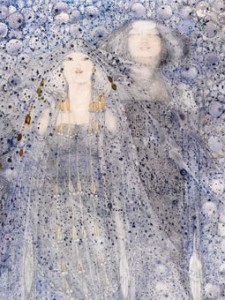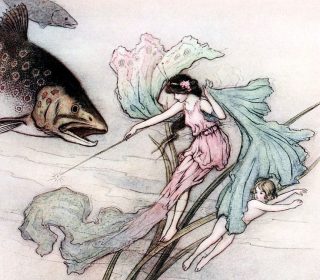The song of wandering Aengus (Silver apples of the Moon) was published in 1899, in the collection of poems “The Wind among the reeds” by William Butler Yeats (1865-1939).
AENGUS: Celtic God of Love
Aengus (Oengus) is the god of love of Irish mythology, belonging to the mythical ranks of the Tuatha De Dannan, eternally young ruler of the Brug na Boinne near the banks of the river Boyne. It is said of him that he fell in love with a beautiful girl seen in a dream and, sick with love, looked for her for a long time before finding and taking her to his kingdom (see the story).
In poetry, however, the character is a young mortal (perhaps the poet himself) in search of his poetic inspiration or the most ancestral side of knowledge. He tells of his initiation into the past, because he became old, in the perennial search for beauty, or poetic enlightenment, embodied by the girl with the apple blossoms in her hair.
The Wandering of Aengus: Silver apples of the Moon
The first to put the poem “The Wandering of Aengus” into music was the same Yeats on a melody composed by Eugène Arnold Dolmetsch: in 1907 he published his essay ‘Speaking to the Psaltery’ in which the poem is recited bardically, sung with the accompaniment of the psaltery; Yeats wrote about the melody of ‘The Song of Wandering Aengus’: “ taken down by Mr. Arnold Dolmetsch from myself,’
Burt Ives with the title The Wandering of Old Angus in ‘Burl Ives: Songs of Ireland‘ Decca DL 8444 (ca. 1954) in the liner notes the Yeats melody is credited (‘Burl Ives learned to chant this William Butler Yeats poem from the late actress Sara Allgood.’) a cappella
Judy Collins with the title ‘Golden Apples of the Sun’ – Golden Apples of the Sun 1962. “Learned from the singing of Will Holt, this stunning song is a musical setting of a W. B. Yeats poem ‘The Song of the Wandering Angus’. The haunting melody is probably the composition of Richard Dyer-Bennet. It is not a folk song, it tends to be an art song. It has a traditional feeling about it; the repetitiveness gives you the impression of an incantation, which the poem does too. Of her learning it I had heard the song almost two years ago..
I lived with the Golden Apples of the Sun almost a year-and-a-half before I ever sang it, and then it burst out one day – almost of its own accord – while I was visiting friends. It took me a long time to assimilate it, but now it’s part of me. I feel that the song has something to do with what people want – what they don’t have – and sometimes the desire for these things is almost as satisfying as the getting.'” Collins sings it dreamily with a touch of melancholy and the accompaniment of the acoustic guitar.
Donovan from H. M. S. 1971 The melody is by him
Richie Havens from “Mixed Bag II” 1974 with his very personal way of playing the guitar, in a remake of Donovan’s piece
Christy Moore from “Ride On” 1986
“I was backstage at Woodstock talking to Jimi when Richie ambled past and hearing my Kildare accent enquired about Aongus and the origin. I told him about Brother Lazerian trying to teach us the beauty of Yeats til it was time for Richie to go on. I heard a rumour that Judy Collins wrote the tune but I got a horrid bollockin in Coolara House one night for suggesting same. Apparently twas Queen Maeve herself that wrote the tune for this one and taught it to Joe Dowd in a dream one night.” (cf)
Paul Winter & Karen Casey from Celtic Solstice 1999
Jolie Holland in Catalpa 2003 American songwriter who combines American folk with country
Waterboys from “An Appointment with Mr Yeats” 2011
an almost spoken version of Mick Scott that closes with the dreamy melody of the flute, like a gust of wind
Tirill in “Nine and Fifty Swans” 2011 Tirill Mohn ex-White Willow in un album tutto dedicato a Yeats
Eoin O’Brien & Darragh Keary 2013
Sedrenn (Elisa Vellianiti and Christine Mérienne) from De l’autri cotè 2013 (the review of the cd here) ♪ music by Elisa Vellianiti
Robert Lawrence & Jill Greene (music by Jill Diana Greene) 2016
|
I |
NOTES |
Aengus il vagabondo
Angelo Branduardi from “Branduardi canta Yeats” 1986 music by Donovan, text-poetic translation by Luisa Zappa
| Fu così che al bosco andai, chè un fuoco in capo mi sentivo, un ramo di nocciolo io tagliai ed una bacca appesi al filo. Bianche falene vennero volando, e poi le stelle luccicando, la bacca nella corrente lanciai e pescai una piccola trota d’argento. Quando a terra l’ebbi posata per ravvivare il fuoco assopito, qualcosa si mosse all’improvviso e col mio nome mi chiamò. |
Una fanciulla era divenuta, fiori di melo nei capelli, per nome mi chiamò e svanì nello splendore dell’aria Sono invecchiato vagabondando per vallate e per colline, ma saprò alla fine dove e`andata, la bacerò e la prenderò per mano; cammineremo tra l’erba variegata, sino alla fine dei tempi coglieremo le mele d’argento della luna, le mele d’oro del sole. |
LINK
http://mudcat.org/thread.cfm?threadid=44244http://branoalcollo.wordpress.com/2011/07/11/le-metamorfosi-di-yeats/http://lebuoneinterferenze.blogspot.it/2010/02/le-mele-della-notte.htmlhttp://www.ilcerchiosciamanico.it/articoli/p2/123/il-regno-sotto-le-acque-il-recupero-dello-sciamanesimo-celtico-di-sharon-paice-macleod.html


